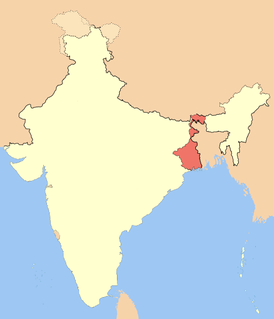Related Research Articles

India is a federal union comprising 28 states and 8 union territories, for a total of 36 entities. The states and union territories are further subdivided into districts and smaller administrative divisions.
This article is about the first election held in Independent India in 1951-52.
Communist Party of India (Marxist-Leninist) Second Central Committee or CPI (M-L) 2nd CC is a political party in India. It emerged in 1973 when the pro-Charu Majumdar faction of the original CPI (M-L) got divided into pro and anti-Lin Piao groups. The CPI (M-L) 2nd CC represents the pro-Lin Piao stream. At present, the party is active in states like Bihar, Uttar Pradesh and West Bengal.

The Provinces of India, earlier Presidencies of British India and still earlier, Presidency towns, were the administrative divisions of British governance in the Indian subcontinent. Collectively, they have been called British India. In one form or another, they existed between 1612 and 1947, conventionally divided into three historical periods:

East India is a region of India consisting of the Indian states of Bihar, Jharkhand, Odisha and West Bengal and also the union territory of the Andaman and Nicobar Islands. The region roughly corresponds to the historical region of Magadha from which it inherits its various Eastern Indo-Aryan languages.

The West Bengal State Assembly Election of 1952 was a part of the series of Legislative Assembly elections in 1952.

The West Bengal state assembly election of 1957 was part of a series of state assembly elections in 1957.
West Dinajpur district was a district of the state of West Bengal from 1947 to 1992. At India's independence, the former Dinajpur district of undivided Bengal was partitioned along religious lines, and West Dinajpur became one of the 14 districts of West Bengal. The other part of the district continues as Dinajpur district of Bangladesh.

This is a list of people elected at the 1952 general election to the Bihar Legislative Assembly. The Indian National Congress (INC) stormed into power. Shri Krishna Singh became the first elected Chief Minister of Bihar and Dr. Anugrah Narayan Sinha became the first Deputy Chief Minister cum Finance Minister of the state.

The States Reorganisation Act, 1956 was a major reform of the boundaries of India's states and territories, organising them along linguistic lines.
The New Bengal Association was founded by Atulya Ghosh, Dhirendranath Mukherji, Jadabendranath Panja, Nalinaksha Sanyal and Sukumar Dutta to press for the Partition of Bengal to create West Bengal as a homeland of the Bengali Hindu people. It along with the Bengal Provincial Hindu Mahasabha and the Indian Association submitted a joint memorandum before the Bengal Boundary Commission for the inclusion of Hindu-majority territories in West Bengal. After the Partition, it campaigned for the inclusion of Bengali-speaking areas of Bihar for their incorporation into West Bengal.

Elections to the Bihar Legislative Assembly were held on 25 February 1957. 1393 candidates contested for the 264 constituencies in the Assembly. There were 54 two-member constituencies and 210 single-member constituencies.
Barada Mukutmoni was an Indian politician, belonging to the Bolshevik Party of India. He briefly served as Minister for Tourism in the state of West Bengal.
The Lok Sewak Sangh, or Manbhum Lok Sewak Sangh, was a political party in Purulia District, West Bengal, India. LSS was founded in 1948. The party was the main political force in Purulia District from the independence of India until the fall of the second United Front cabinet.

The Zamindars of Bihar were the autonomous rulers and administrators of the Mughal subah of Bihar and later during British rule. The zamindars of Bihar were numerous and could be divided into small, medium and large depending on how much land they controlled. Within Bihar, the zamindars had both economic and military power. Each zamindari would have their own standing army which was typically composed of their own clansmen.
Lal Behari Das was an Indian politician and former member of the West Bengal Legislative Assembly. He served as the representative of the Khejuri constituency between 1956–1957 as a member of the Praja Socialist Party. He was elected to the constituency in a by-election and his candidacy was supported by the Communist Party of India which campaigned in opposition to the proposed merger of West Bengal and Bihar. The Khejuri constituency was abolished for the 1957 West Bengal Legislative Assembly election while Das contested and lost on the seat of Bhagawanpur.
Mohit Mitra was an Indian politician and former member of the Lok Sabha of India. He served as a representative of the Calcutta North East constituency between 1956–1957 as a member of the Communist Party of India. He was also the member of the Central Committee of the Communist Party as its secretary of linguistic reorganisation of state. Following the death of Meghnad Saha, Mitra was appointed as the candidate for the Calcutta North East constituency for a by-election in 1956 and his candidacy was declared a political statement in opposition to the proposed merger of Bihar and West Bengal. He subsequently won the election with a reportedly "huge margin". The Calcutta North East constituency was abolished for the 1957 Indian general election while Mitra contested and lost on the seat of Calcutta North West.
References
- ↑ "West Bengal—Bihar Merger: Hallahal follows Amrit !" (PDF). Economic & Political Weekly . 24 March 1954.
- ↑ Sarkar, Shamita (2013). "The role of the Communists in the Anti Bengal—Bihar Merger Agitation". Proceedings of the Indian History Congress. 74: 921–924. ISSN 2249-1937. JSTOR 44158893 – via JSTOR.